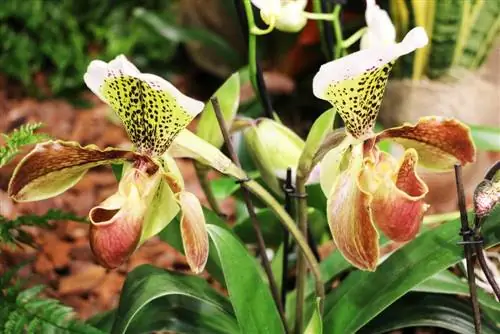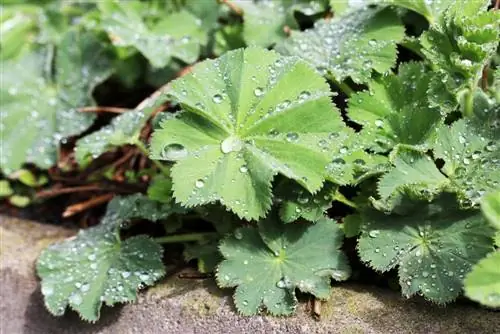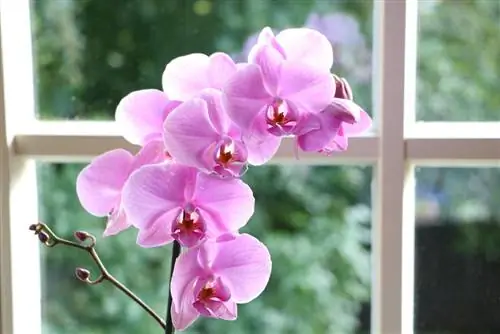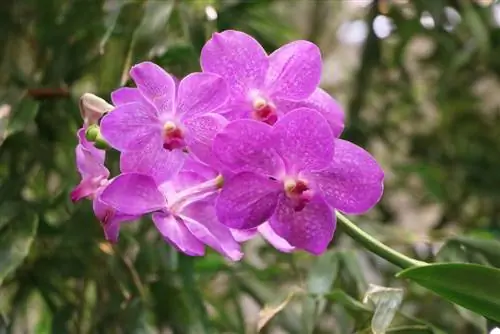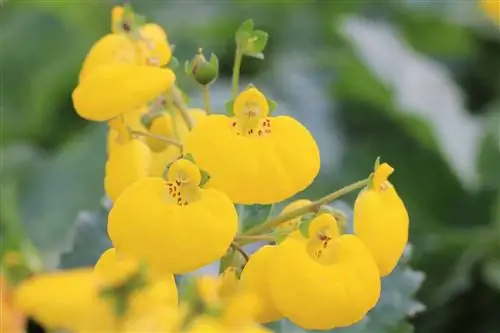- Author admin [email protected].
- Public 2023-12-17 03:39.
- Last modified 2025-01-24 12:45.
All orchids enrich us with shapely and long-lasting flowers, making them one of the most popular plants for the windowsill at home. Paphiopedilum is particularly creative, with a colorful flower whose unusually shaped lower petal is actually reminiscent of a lady's slipper. However, this exotic flower needs a suitable location and special care in order to stay he althy and regularly create “blooming shoes”.
Subspecies
The correct German name for the lady's slipper orchid is Venusschuh. In English it goes by the name “Ladyslipper”. There are more than 100 subspecies, all of which differ in the appearance of the leaves and flowers. The flower colors range from yellow, orange, red, pink and green. Dot-shaped drawings or vein-like lines add further accents and create additional contrast.
The plant is native to tropical regions of South Asia and also loves warm temperatures and high humidity here. However, there are subtle differences between the individual subspecies when it comes to care and location requirements. Roughly speaking, species with green foliage like shade, which is most likely to be found on the north window. If the orchid species has multiple flowers or has spotted foliage, then it should be a little lighter.
Attention:
Lady's slipper orchids of the genus Paphiopedilum are not hardy. This genus should not be confused with the hardy lady's slipper orchids of another genus that come from Siberia. The hardy lady's slipper orchids have completely different care requirements.
Toxicity
The lady's slipper orchid is slightly poisonous. The toxic substances are found in the leaves and stems. Eating these parts of the plant would result in vomiting and diarrhea. Particular caution is required if small children or pets live in the household.
Contact with the plant sap can also lead to contact allergies in sensitive people. Therefore, use gloves for all care measures that require direct contact with the plant. After use, clean your cutting tool thoroughly with water.
Location
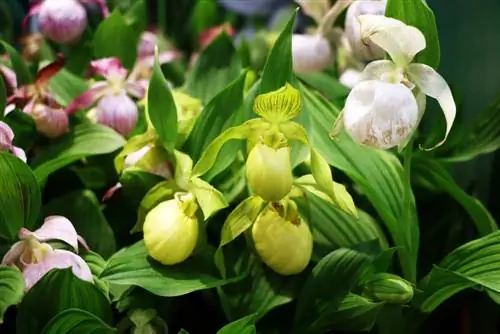
Orchids are among the most popular plants for the windowsill, also because, unlike other houseplants, they require a small pot that fits wonderfully on the windowsill. However, not every window seat is equally suitable for the Venus slipper orchid. There are also subtle differences between the individual species.
When purchasing, pay close attention to the care instructions provided. In general, a warm and bright place without direct sunlight is ideal. Furthermore, these orchids should not be exposed to drafts. In winter, a place near the heater is not good as the dry air is not well tolerated by the orchids.
Outdoor location
In the warm summer months of June to August, green-leaved Paphiopedilum orchids are allowed outside on the balcony or in the garden.
The ideal place is:
- partially shaded to shady
- without direct midday sun
- sheltered from the wind
- with summer temperatures not exceeding 30 °C
Substrate
Conventional potting soil cannot meet the needs of the lady's slipper orchid. On the one hand, they have a very high water requirement, but on the other hand, the roots rot when waterlogged. A substrate, on the other hand, absorbs water well and releases it slowly. This prevents waterlogging.
Orchids that are available for purchase in stores are already planted in a suitable substrate. When repotting, you should also make sure to only use suitable substrate. It is mainly made of organic materials such as raffia, coconut fiber, moss, bark and wood. Styrofoam beads loosen up and charcoal added disinfects. Special substrates with different grain sizes are available commercially.
Tip:
Young and small Paphiopedilum require a finer substrate than older and larger specimens.
Pouring
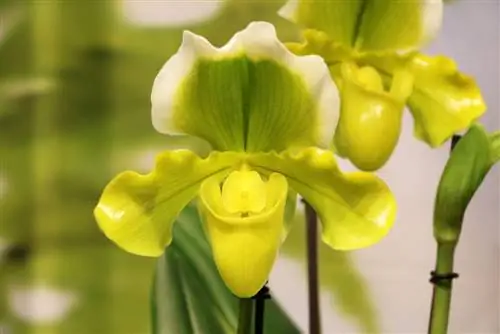
In their ancestral homeland, orchids absorb water directly from the moist air with their strong roots. However, the humidity on the windowsill at home is comparatively low. The orchid must therefore only be supplied with water and nutrients through watering.
However, their roots, which are hairy at the tip, are sensitive to waterlogging. The leaves should also not come into contact with water when watering because it collects in the heart and causes rot on the flower stem. It is better to immerse the entire pot in the water for a few minutes so that the substrate is soaked. Then make sure that no water collects in the saucer or planter. Pour away the excess water immediately.
Dryness also damages the roots, which is why the substrate must never dry out completely. As soon as it noticeably loses moisture, the next dive is due.
Tip:
Use rainwater or softened water for watering. When leaves are sprayed to increase humidity, there is a risk of water pooling in the axils. The orchid doesn't like this and reacts quickly with rot in these areas.
Fertilize
The lady's slipper orchids need a lot of nutrients and must be fertilized regularly. A commercially available orchid fertilizer is added to the irrigation water. Fertilize should be done every 2-3 weeks in summer and every 4-6 weeks in winter. The lime from crushed mussels is also a good long-term fertilizer. It promotes the growth of the lady's slipper orchid and, above all, ensures more beautiful flowers.
Note:
The mussels should be washed thoroughly before crushing to remove any sea s alt.
Repotting
So that the roots of the lady's slipper orchid can always absorb enough water, regular repotting is necessary. The time interval until the next repotting is about a year. The following characters indicate the need:
- The entire surface of the pot is covered by the leaves
- Almost only roots can be seen on the outside of the pot
- Roots growing out of the pot
- The substrate rots
- S alts have settled on the surface of the substrate
Spring and autumn are good for repotting. The old pot can still be used because the lady's slipper orchid likes narrow pots. Otherwise, the new pot may only be slightly larger.
- Carefully pull the plant out of the old pot without damaging the roots. If necessary, cut the pot.
- Shake off old substrate.
- Cut off damaged roots generously. Use a sharp and sterile knife.
- Place the lady's slipper orchid with the roots in the new pot.
- Fill the gaps with substrate.
- Stand the pot firmly up again and again so that the substrate sinks down.
- Submerge the pot in water for a while so that the substrate can soak up.
- Afterwards, make sure that no water collects in the saucer or planter. Otherwise, throw it away immediately.
Cutting
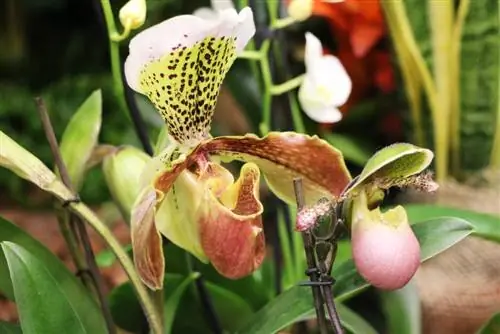
When cutting the lady's slipper, not only the root but also the leaves are cut:
cutting leaves
In the course of the normal aging process, individual orchid leaves repeatedly wilt. And as soon as the lower leaves of the Venus slipper start to wilt, it is tempting to cut them off immediately. They disrupt the harmonious overall appearance of the orchid and give an unhe althy impression. However, these leaves should not be cut. The lady's slipper orchid does not require pruning nor is it recommended. The open interfaces allow fungi and bacteria to easily penetrate and damage the orchid. Be patient and wait until the leaves are completely dry.
Dry leaves fall off on their own or can be easily removed by hand. Green leaves should only be cut in the event of disease or pest infestation. Then always use a sharp and disinfected knife. The entire leaf is always cut, even if it is only partially damaged.
Cutting roots
He althy roots should not be cut as they contribute to the growth of the plant. However, sometimes it happens that roots rot due to too much watering. Therefore, check the condition of the roots at regular intervals. This is very easy because special orchid pots are usually transparent. If you discover rotting roots, remove them as soon as possible.
- Use a sharp knife.
- Sterilize the knife with alcohol or hot water.
- Cut off any rotting roots.
- Disinfect the interfaces with carbon powder.
Cutting flower stems
The lady's slipper orchid is one of the varieties of orchids from which faded and dried flower stems should be cut off. The lady's slipper orchid only produces its flowers on new shoots. As soon as the dried flower falls off, the stem can be cut to the base. Stems that are completely brown and dried out can be cut anyway.
Cut off faded or dried flower stems all the way down to the bottom with a sharp knife or scissors. A new shoot then develops and blooms once it has reached its full size. Of course, freshly blooming stems can also be cut for the vase or for a flower arrangement. Always use a clean and sterile tool and cut the stem down to the bottom.
Propagation
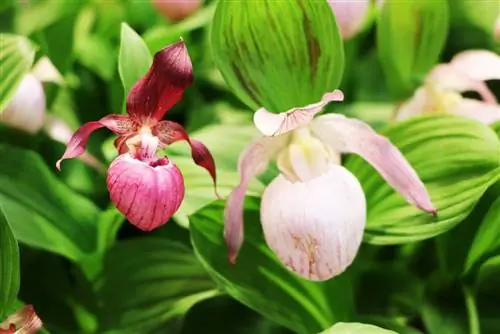
The lady's slipper can be propagated from seeds, although this is quite complicated for laypeople. In practice, this procedure is only used in the laboratory by professionals. Vegetative propagation, on the other hand, is quite easy for everyone. Over time, the orchid develops new areas of vegetation on its rhizomes. When the plant has at least six new shoots, it can be divided. This is best done the next time you repot, as soon as the flowering period is over.
- Sterilize a sharp knife with boiling water or alcohol.
- Pull the lady's slipper orchid out of the pot without damaging roots.
- Shake the roots immediately so that the substrate falls out completely.
- Cut the rhizome with the knife so that at least two plants remain on each section.
- Replant the old plant.
- Plant the cut section in a new pot. Only use suitable substrate for this.
- Spray the substrate (not leaves!) of the new plant frequently with water. Make sure that no water gets on the leaves.
Flowering time
Spring and autumn are the main flowering times for paphiopediles. The flowering period is 1-2 months. During this time, the lady's slipper orchid places special demands on care. Large temperature fluctuations and drafts must be avoided. Larger types of flowers may require a support rod that is attached to the flower stem. Many hybrid varieties also bloom all year round.
Diseases and pests
If the lady's slipper orchid is weakened by care errors, especially due to moisture, it is susceptible to fungal diseases. These can be recognized by leaf spots and rot in the root area and on the leaves. Remove the orchid from the damp soil immediately. The affected plant parts must be cut off with a sharp and sterile knife. Then repot the plant in fresh substrate.
Scale insects like orchids and like to settle on the underside of the leaves, where they are overlooked for a long time. The damage is obvious when the leaves of the lady's slipper orchid become deformed and wilt. Act quickly if your orchid is infested with scale insects. The affected plant should first be isolated from other plants to reduce the risk of infection.
Some biological agents are available for the subsequent control of scale insects. For example, a mixture of one liter of warm water and about 15 grams of soft soap or two tablespoons of olive oil and a splash of dishwashing liquid. The mixture is carefully applied with a brush. If the infestation is persistent, the procedure should be repeated after fourteen days.
Wintering
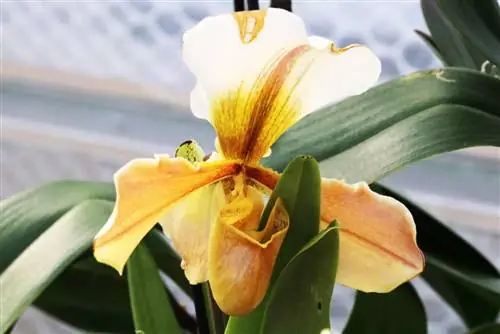
The lady's slipper species with solid green and narrow leaves are the only species that require a few months of winter rest. During this phase the temperature should be significantly reduced. Temperatures between around 15 degrees are ideal. All other species like consistent temperatures around 20 degrees in winter.
All lady's slipper orchids must not be placed on window sills close to a heater. The dry heating air is not good for these moisture-loving plants. A bright place protected from drafts and without direct sunlight is also recommended in winter. Water requirements are lower in winter, so watering can be reduced. In winter, fertilizer applications once a month are completely sufficient.
Tip:
So that you can be completely sure what needs your orchid species has, you should ask specifically about them every time you buy a new one.

